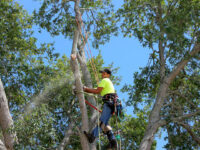What You Need to Know About Disaster Cleanup
Utah Disaster Cleanup involves a lot of things. It’s not just fire damage from a natural disaster like an earthquake or a tornado, but also flooding from a storm or even broken pipes.
Disaster recovery work exposes workers to obvious hazards and hidden dangers such as downed power lines, contaminated water, carbon monoxide, mold and other health risks. Responsible cleanup strategies include safe demolition, hazardous material removal and environmental testing.
During the aftermath of a disaster, it’s important to assess the damage. This will allow you to determine what can be salvaged and the best way to restore your home or business. This assessment will also help you decide whether to seek professional assistance. Regardless of the type of disaster, an effective assessment will save you time and money.
Disasters such as hurricanes, tornadoes, earthquakes, mudslides, and floods can all cause extensive damage that requires emergency restoration services. These repairs are often expensive and time-consuming, so it’s important to have a disaster cleanup plan in place before the event happens. An effective disaster recovery plan will include a list of all damaged items, an inventory of your building’s structural integrity, and the necessary supplies to get the job done right.
When a disaster strikes, it’s easy to miss the damage because it can be hidden from view. Fortunately, satellite imagery can detect many different types of disaster-related damage, such as collapsed buildings and cracks in bridges. But this technology is not foolproof, and it’s still essential to have a team on the ground with the expertise to extract operationally-relevant information from raw satellite data.
A detailed damage inspection is conducted on site by FHWA field staff, primarily to verify the extent of damaged highway facilities and make a rough estimate of repair costs eligible for ER funding. The resulting damage survey summary report is used by the Division Administrator to make a determination of eligibility for natural disaster assistance.
These inspections typically focus on the major elements of the transportation system and are conducted in conjunction with local emergency management officials. In addition to FHWA field engineers, other State and Federal transportation personnel may be assigned to this task.
Disasters can leave behind a wide range of contaminants that threaten public health and safety. Air pollution from burning debris, contaminated water from chemical runoff, and soil degradation are just a few of the risks that can occur when disaster cleanup isn’t completed correctly. Sustainable disaster cleanup methods like safe demolition, hazardous material removal, and environmental testing ensure compliance and support long-term recovery. By leveraging these tools and working with an experienced 8(a) contractor, you can reduce environmental harm and speed up the disaster recovery process.
Make a Recovery Plan
Before you can begin cleaning up after a disaster, it’s important to make a recovery plan. This will help ensure that your data is protected and your systems are up and running as quickly as possible. It’s also a great way to organize your work, allowing you to tackle the tasks at hand in a logical fashion.
A well-written disaster recovery plan will detail the major goals of your company and include an incident response plan. It will also identify what areas are most important to your business and what level of downtime is acceptable. This is a great way to create a prioritized list of items that need to be restored first, which can help reduce the overall impact on your operations and end users.
It’s crucial that your team members are familiar with their roles and responsibilities. This will prevent misunderstandings in the heat of the moment and ensure that all necessary steps are taken. It’s also a good idea to designate backups in case a key team member is unable to participate for any reason. In addition to establishing responsibilities, it’s important to communicate clearly during the disaster recovery process.
In order to prepare for a disaster, you need to develop and test your disaster recovery plan. A successful recovery depends on having access to your backups, confidence in the integrity of those backups, and an ability to bring your systems back online at a moment’s notice. A solution like Pure Storage will assure all of these, as well as provide a smooth and seamless transition between on-premises and cloud environments.
Creating an effective recovery plan forces businesses to take a close look at their physical assets. This can lead to a long-overdue inventory that will reveal any equipment that may need replacing or upgrading. In addition, it’s a great opportunity to update and review the disaster recovery plans that were previously put in place.
It’s also a good idea to communicate with stakeholders and outside agencies that will have a direct impact on the disaster recovery strategy. Keeping them updated will allow you to get the word out quickly and respond to their needs in an efficient manner. This is the best way to ensure that your clients and customers are protected and well-informed.
Get the Right Equipment
Whether you are doing the cleanup or enlisting a professional restoration company, there are supplies and equipment that are required to complete the job. These include cleaning and sanitation supplies, dehumidifiers, and many other tools.
Disaster clean up is a dangerous job that poses numerous risks including electrical hazards, fires, carbon monoxide poisoning, confined spaces, structural instability, heavy equipment and power lines. Workers should be provided with the proper safety gear and trained to use the right tools for the job.
Sustainable disaster cleanup reduces waste by recycling, eco-friendly decontamination and selective demolition. Green technologies like biodegradable absorbents and filtration systems help minimize environmental harm and long-term damage. Partnering with specialized 8(a) contractors ensures compliance, efficiency and responsible cleanup tailored to complex disaster recovery.
Get Help
Disaster Cleanup workers are exposed to a wide range of work-related hazards. These include electrical hazards, carbon monoxide, musculoskeletal risks, thermal stresses, and exposure to sewage and other toxic substances. The continuous long hours of work can also cause stress and fatigue. It’s important to set priorities and pace yourself when working on cleanup and recovery tasks. Take breaks frequently to avoid physical exhaustion. Get emotional support from family and friends, and seek professional mental health services if needed.
Hiring professionals for disaster cleanup ensures that your home is safe to return to. Professionals also know how to preserve and restore valuable items, helping families find peace of mind in the aftermath of a natural disaster. Additionally, they understand how to navigate insurance claims and legal requirements, ensuring that the process is as smooth as possible for property owners.






